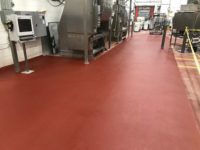Best practices for maintaining an allergen-free snack or bakery facility
Allergen-free facilities use testing and best practices to ensure quality, safety




Controlling allergens is vital in snack and bakery facilities that seek to remain 100 percent allergen-free. The first step is to establish best practices, as well as regularly testing the production environment and finished products for presence of allergens.
Best practices
“The top best practice is avoidance of allergens completely within the facility that wishes to remain allergen-free,” says Chris DeVore, quality assurance manager, Enjoy Life Foods, Chicago.
Enjoy Life Foods manufactures allergen-free products. All of its products are gluten-free, dairy-free, soy-free, and egg-free, as well as free from other common allergens, like wheat, peanuts, tree nuts, casein, and more.
“The key is knowing not only what allergens a supplier has in both their facility and on their lines, but in what form that allergen exists. For example, liquid milk poses a far less risk than a milk or cheese powder, from a contamination perspective,” comments DeVore. He says that the next step in the process is full testing of those products for which the risk of allergen cross-contamination is present and high.
“Testing of all ingredients at the point of receiving will prevent a potentially contaminated ingredient from entering the process. Full exclusion is essential to cross-contamination prevention,” DeVore remarks.
The third step is controlling employee practices. While a product can be allergen-free from exclusion, it is hard to exclude all allergens from inclusion in the effects from employees—for instance, their lunches, says DeVore. “While we can restrict and completely ban peanuts and tree nuts, we cannot expect to exclude things like wheat bread. Therefore, heavily enforced good manufacturing practices that require employee hand-washing, outer garment protections including removal prior to entering restricted areas—such as lunch rooms—and other controls are necessary.”
Homefree, LLC, Windham, NH—another allergen-free producer—has many of the same policies.
“In order to prevent cross-contact, we do not allow gluten and the top allergens—other than soy lecithin—into our facility for any reason, including employee lunches,” says Jill Robbins, president. “Further, when we interview staff, an important part of the interview is about the responsibility that they would be taking on with regard to allergen-related care, such as not handling peanut/nut products prior to coming to work. Then our staff wears our uniforms, which we wash in-house, and also our shoes, so that our staff are not inadvertently tracking allergens into the kitchen.”
Robbins says that they source their ingredients carefully to be sure that they have not been processed in facilities with allergens or gluten. “As an extra precaution, we randomly conduct ELISA testing down to 10 ppm on the ingredients and finished product. We also wipe down all ingredient packaging before bringing it into the kitchen.”
Some facilities might simply work to maintain an allergen-free zone within a snack or bakery facility. Some examples of methods to prevent cross-contact could include ensuring that production utensils and maintenance tools do not transfer an allergen from one area to another, says Bill Steadman, regional manager, North America, food safety, AIB International, Manhattan, KS. “You should also ensure that personnel practices don’t result in transfer of allergens from one production line to another—e.g., by ensuring employees do not handle food containing an allergen and food that does not without washing hands and changing outer garments.”
Minimizing the transfer of dust that could contain allergens is also important, Steadman notes. “With the onset of FSMA, the term ‘cross-contact’ is no longer synonymous with ‘cross-contamination.’ FDA has now defined cross-contact as the unintentional incorporation of a food allergen into a food, whereas cross-contamination deals with contamination from insanitary conditions from personnel, equipment, food-contact surfaces, or raw versus cooked product,” he says.
Testing methods
There are various ways to test for allergens, explains Steadman. Here are a few:
- Immunochemical methods: ELISA, lateral flow devices (dipsticks), multiplex (tests for multiple proteins)
- DNA-based methods: PCR, multiplex
- Mass spectrometry: process that identifies proteins and peptides with a high level of accuracy
- Generic or non-specific (cleaning): protein swabs, ATP, and visual inspection (visually free)
There are a wide variety of testing kits and procedures available to snack and bakery producers, with the most-common being quick swabs and kits that can be screened for the presence of allergens, says DeVore. “Swabs or cleaning rinses can be assayed for the chosen allergen. There are many kits on the market available for a wide variety of allergens. However, there are restrictions to these kits,” he cautions. For example, while it is easy to screen for peanuts, milk and soy, screening for all tree nuts can be difficult, as there are not always those types of kits available, he notes. “Therefore, the best method is exclusion, and validation through product testing.”
Testing equipment
“The best methods currently available are ELISA-based immunological methods,” says DeVore. “These kits are not very cost-prohibitive, and multiple samples can be tested at once depending upon the test kit being used.”
There are emerging technologies that further ELISA methods, such as X-MAP and the use of HPLC or GCMS, but these methods currently employ equipment that is highly expensive, or the methodology involves multiple kits to be used, which is cost-prohibitive for the average manufacturer, explains DeVore. “The ELISA kits are the best solutions we have right now for rapid test result achievement, less cost to pass on to the consumer, and accuracy—as long as they are validated for the products you wish to treat,” he notes.
“Equipment and procedures for testing finished products will depend upon the method of testing selected,” says Steadman. “For greatest accuracy, a quantitative method—e.g., ELISA, DNA-based or mass spectrometry—would be recommended, as these types of methods can provide an actual value as a result, rather than just a ‘yes/no’ or ‘present/not present’ answer.”
Steadman says that the different methodologies that are available have significant differences in the types of equipment and reagents that are needed, and varying levels of proficiency and training required for the analysts conducting the testing. “Costs for running the differing analyses can also vary substantially,” he explains.
“Supplier verifications, allergen restrictions through GMP programs, and ingredient and finished-goods testing are the top three things that are required for any facility looking to be allergen-free,” says DeVore.
Training of employees, and employing individuals with an extensive knowledge about allergens, are of the utmost importance.
“Allergens are everywhere, and it’s hard to source from suppliers who are completely allergen-free,” DeVore explains. “Therefore, constant vigilance, testing and understanding of the supply chain pieces can go a long way toward fostering a very strong, allergen-free facility.”
Looking for a reprint of this article?
From high-res PDFs to custom plaques, order your copy today!












